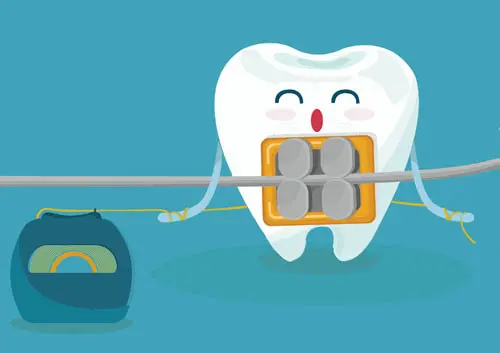Braces are an important treatment for straightening teeth but can get in the way of your normal oral health care routine. In particular, it can be a real hassle to floss with braces. But flossing every day is important during braces treatment, so you will have to learn how to do it properly for 15 to 18 months until the braces come off.
What are braces?
Braces, whether traditional metal or ceramic, is a method to fix teeth and jaw misalignments such as overcrowding, gaps between teeth, crookedness, overbite, underbite, and crossbite.
Brackets are bonded to each tooth with an adhesive. Wires and elastic bands serve as anchors to the brackets. Braces gradually place pressure on teeth to shift them over a period of time.
What is flossing?
Flossing is the use of a piece of wax-covered thread to clean between teeth in order to scrub hard-to-reach food and sugar particles off the surface of the enamel that brushing didn’t clean as efficiently.
Is it difficult to floss with braces?
Flossing with braces can be frustrating because the wire running through the brackets gets in the way of moving the floss between your teeth. Without braces, flossing is quick and easy as you just place the thread between the teeth and move it back and forth before popping the thread out and moving to the next space. But with braces, flossing takes more time because you have to thread it under the wire.
How do I floss with traditional braces?
While flossing with braces can be frustrating, it can be done by following a series of simple steps that will keep your teeth clean and prevent damage to your hardware.
- Cut an 18 to 24-inch length of floss away from the floss holder
- Dampen one end of the thread to stiffen it
- Carefully thread the floss under or over the wire and floss gently between the teeth.
- Remove the floss by carefully pulling it back out the way you threaded it
- Don’t pop it out as you normally would without braces to avoid damaging the wire
- Move on to the next space and repeat until completion
What other products can I use to floss with braces?
The good news is that you don’t have to rely on the process of traditional flossing in order to floss with braces. There are products available on the market that can assist you with this crucial part of your daily dental care routine.
-
Floss threader
A floss threader is a device that works by making threading the floss under the wire much easier and convenient. This is especially good for those who have bigger fingers or can’t hold onto the floss steady enough to pass it under or over the wire.
Cut an 18 to 24-inch piece of floss and pull it through the eye of the plastic needle. No need for alarm. This plastic needle simply secures the end of the thread so you can pass it under or over the wire with ease. Hold the floss threader in one hand and the free end of the floss in the other.
Begin flossing between the teeth as normal and then carefully pull the thread out and repeat the process until flossing is complete.
You can purchase disposable and reusable floss threaders at the pharmacy or a supermarket where oral healthcare products are sold. They cost between $5 and $10.
-
WaterPik
WaterPik is a special tool that is also known as an oral irrigator. Instead of traditional floss thread, a steady stream of water cleans between the teeth and along the gumline to wash away food and sugar particles.
Simply fill the reservoir of the device with water. Feel free to add mouthwash to kill bacteria and strengthen enamel.
Insert the tapered tip on the flosser and test the water pressure to make sure it’s strong enough.
Place the tip of the flosser in your mouth and begin spraying a stream of water between your teeth. Be sure to lean over the sink to allow water to run out of your mouth. Move along to each space between your teeth for a thorough cleaning and then rinse. This process should only take a few minutes to complete.
Empty the reservoir and dry off the device. Store in a container for safekeeping. You can purchase oral irrigator tools for around $50.
-
Dental tape
Dental tape is used like traditional floss, but it’s thinner and wider. It’s also smooth and spongy. These traits make dental tape more comfortable and a little easier to use, especially for those who don’t regularly floss.
Why is flossing with braces important?
Flossing with braces is important because braces can trap food particles and sugar between your teeth. Braces also increase your risk of developing cavities and harmful bacteria that can cause gum disease and tooth decay.
Benefits of Flossing
- Removes plaque
- Prevents cavities
- Prevents gum disease
- Reduces bad breath
Dangers of Not Flossing
- Develop cavities
- Plaque buildup
- Develop gum disease
- Tooth loss
- Possible heart attacks because heart health is linked to oral health
Does flossing hurt?
Flossing is not supposed to hurt. However, you can experience discomfort, bleeding, and swelling in your gums if you floss too vigorously or don’t do it regularly. These symptoms should go away with regular and proper flossing. If symptoms persist, see a dentist as soon as possible.
Contact Centralia Orthodontics Today
In the end, while flossing with braces is important, the best way to receive a thorough cleaning between your teeth is to regularly see your dentist or orthodontist for cleanings that not only provide your teeth and gums with a deeper clean but also clean your braces as well.
Dr. F. Andrew Lasley and the Centralia Orthodontics staff proudly serve Centralia, Chehalis, and Rochester in Washington. We are ready to provide you with the dental care you need. We use the most up-to-date techniques and technology and we are happy to answer any questions you may have. Just call us at 360-736-0129 or visit our website to begin your journey to a healthier smile today!







